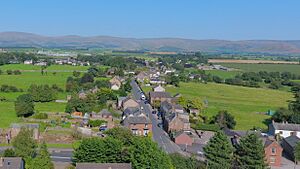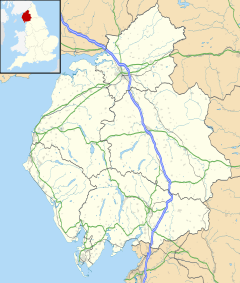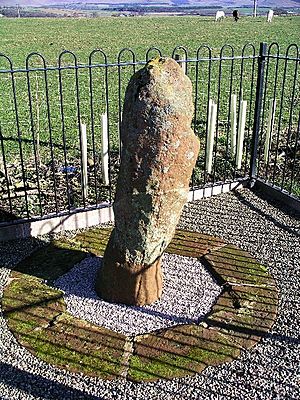Kirkby Thore facts for kids
Quick facts for kids Kirkby Thore |
|
|---|---|
 Kirkby Thore from the A66 |
|
| Population | 758 (2011) |
| OS grid reference | NY639257 |
| Civil parish |
|
| District |
|
| Shire county | |
| Region | |
| Country | England |
| Sovereign state | United Kingdom |
| Post town | PENRITH |
| Postcode district | CA10 |
| Dialling code | 017683 |
| Police | Cumbria |
| Fire | Cumbria |
| Ambulance | North West |
| EU Parliament | North West England |
| UK Parliament |
|
Kirkby Thore is a small village in Cumbria, England. It is close to the amazing Lake District national park and the Cumbrian Pennines mountains. The village has areas called Bridge End and Cross End. In 2011, about 758 people lived here. The market town of Appleby-in-Westmorland is about 5 miles (8 km) away. The larger town of Penrith is about 8 miles (13 km) away.
Contents
A Look Back in Time: Kirkby Thore's History
What's in a Name?
The name 'Kirkby Thore' was first written down in 1179. Kirkby means 'church village' or 'village with a church'. Thore is an old name from the Old Norse language. It is linked to the Norse god Thor.
Roman History in Kirkby Thore
The village sits on the site of an old Roman army camp. This camp was called Bravoniacum or Brovonacae. Many Roman items have been found here over the years. These include coins, tombstones, sandals, pots, and even a spear tip.
Between 208 and 211 CE, a special group of Roman soldiers lived at Bravoniacum. They were light cavalry from Numidia, a region in North Africa. This means they were the first African community in Britain!
A Roman road called the Maiden Way started here. It went north from Bravoniacum to other Roman forts. One of these was Epiacum (Whitley Castle) near Alston. It then joined the Stanegate road near Hadrian's Wall. In 2016, a special technology called LIDAR found another Roman road. This road runs southwest from Kirkby Thore.
Old Buildings and Industry
The Anglican church of St Michael in Kirkby Thore is very old. It is made of red sandstone and was built during Norman times. The village also used to have a Methodist chapel.
Kirkby Thore Hall is another important old building. It is a medieval Manor House. It has special features that make it interesting to study.
For over 200 years, a mineral called Gypsum has been dug up here. The local British Gypsum factory has made plaster since 1910. They have made plasterboard since the 1960s. Today, it is cheaper to bring gypsum by train from a power station. But the factory still uses a private railway line.
There are also many farms in and around the village. Some are large farms that raise dairy cows. Others raise beef cattle or sheep. Some farms also grow crops.
How Kirkby Thore is Governed
Kirkby Thore is part of the parliamentary area called Penrith and the Border. A Member of Parliament (MP) represents this area in the UK Parliament. An MP is a person elected by the people to speak for them in the government. Neil Hudson was elected as the MP for this area in 2019. He belongs to the Conservative Party.
Getting Around and Village Services
The busy A66 road runs along the western edge of the village. There are plans to make this road bigger with two lanes in each direction. This would make travel easier and safer.
The village has several useful places. There is a village shop where you can buy things. It also has a post office. There is a filling station (petrol station) that also has a shop. You can also find a bistro in the village that serves meals.
Famous People from Kirkby Thore
Two famous siblings, Helen Skelton and Gavin Skelton, grew up on a farm near the village. They went to Kirkby Thore Primary School.
- Helen Skelton is now a television presenter. She is well known for working on shows like Blue Peter and Countryfile.
- Gavin Skelton is a professional footballer. He has played for teams in the Scottish Premier League. He has also been a player-manager and an assistant manager for football clubs.
See also
 In Spanish: Kirkby Thore para niños
In Spanish: Kirkby Thore para niños




